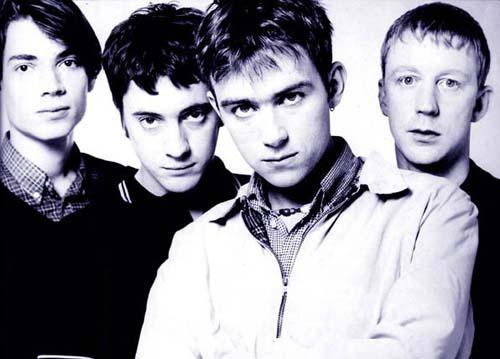The history of BLUR can be traced back to circa 1980, when Damon Albarn (b.1968) and Graham Coxon (b.1969) met as schoolboys at Stanway Comprehensive School in the fair city of Colchester in Essex, where they sang together in the choir. Both were drawn to music. Damon, a Londoner by birth (Whitechapel Hospital), was the son of Keith (a former luminary of England's late-1960's psychedelic rock scene that yielded Soft Machine and others) and Hazel (a stage designer for Joan Littlewood's theatre company). Arriving in Colchester in the late '70's, the young Damon began studying music (the piano) and drama.
Graham, who had been born on an airbase in Germany, was the son of a bandsman and he had gravitated to Colchester in 1977. Graham was encouraged at Stanway to learn the saxophone, an instrument which -- some 15 years later -- he would play for the first time as a member of BLUR on "Jubilee" (on "Parklife"). Aged 12, Graham also began to play the guitar.
Alex James grew up in Bournemouth on England's south coast, coming to London in the late '80's to study at Goldsmith's College, where he first met Graham
Colchester-born Dave Rowntree, the son of a BBC sound engineer and a mum who played in an orchestra, "took up" the bagpipes at a young age of "very youthful indeed," graduating to drums not long afterwards.
These four men formed a bizarre, Brechtian art-punk band called Seymour--Damon on vocals (and occasional keyboards), Graham on guitar, Alex on bass, and Dave on drums. After laying a dozen or so shows in and around London, they re-named the band BLUR in 1989. BLUR signed to Food Records in late 1989.
The first release from BLUR was the single "She's So High," in 1990. The story really began to gather speed with the next single, "There's No Other Way," a sizable hit in Britain in the Spring of 1991. The song saw BLUR working for the first time with the legendary producer Stephen Street (The Smiths, Morrissey, The Cranberries). Street has produced the bulk of BLUR's music ever since, including all but one track on "Parklife" and every song on "The Great Escape" and "Blur."
"Leisure," BLUR's debut album, released in August 1991, was an enjoyable collection of songs influenced by Syd Barrett's Pink Floyd, the explosive guitars of My Bloody Valentine and vocal harmonies reminiscent of "Revolver"-era Beatles. A Number 7 hit in Britain, "Leisure" was soon outgrown by BLUR, who announced a complete change of attack on their great, "lost" single "Popscene" in March 1992: furiously-paced, with blaring horns over punky guitars.
Damon had undergone a major transformation as a songwriter: from reticent by-stander to caustic commentator, and BLUR greedily stockpiled the songs that would make up their sophomore effort, the critical breakthrough "Modern Life Is Rubbish." Named after a piece of graffiti scrawled on a wall near London's hallowed monolith Marble Arch, "Modern Life Is Rubbish" (released in May 1993) was a total sea-change. Flying in the face of fashion, it was a huge pop encyclopedia of England (from Julian Cope to XTC, from the Beatles to Madness). The album's witty and touchingly parochial songs (variously bolstered by the use of string sections, brass sections and cor anglais (aimed for -- and achieved -- a quintessential English sound not heard since the 1965-68 heyday of The Kinks.
This modern view of urban England was developed on the third BLUR album, "Parklife" (a Number One chart entry in April 1994), which took an analytical, often comical look at England's foibles and misfortunes. The music created by BLUR -- guitars, bass, saxophones, drums, and insane keyboards -- drew from many classic English influences (Kinks, Madness, Bowie, Magazine) to create a palette that was inspirationally fresh and defiantly colloquial. The band won four Brit Awards for "Parklife" in early 1995.
Some months in the making, the much-misunderstood "The Great Escape" was Blur's worldwide coming of age. Its musical reach far outstripped traditional pop: banjo, Mellotron, curdled waltzes and zonked out keyboards all took a bow in the band's ingenious arrangements. The album would have sounded novel in whichever country it was heard. It spanned every age group (BLUR are the first group ever to receive front cover stories in the teen mag Smash Hits and the thirty-somethings' monthly Mojo).
"The Great Escape" shot straight into the British album charts at Number 1 -- it sold over 1 million copies in the UK alone -- and is to-date BLUR's biggest-selling album worldwide. A tour of British seaside resorts followed, during which BLUR played to small audiences for one last time.


